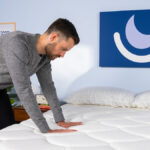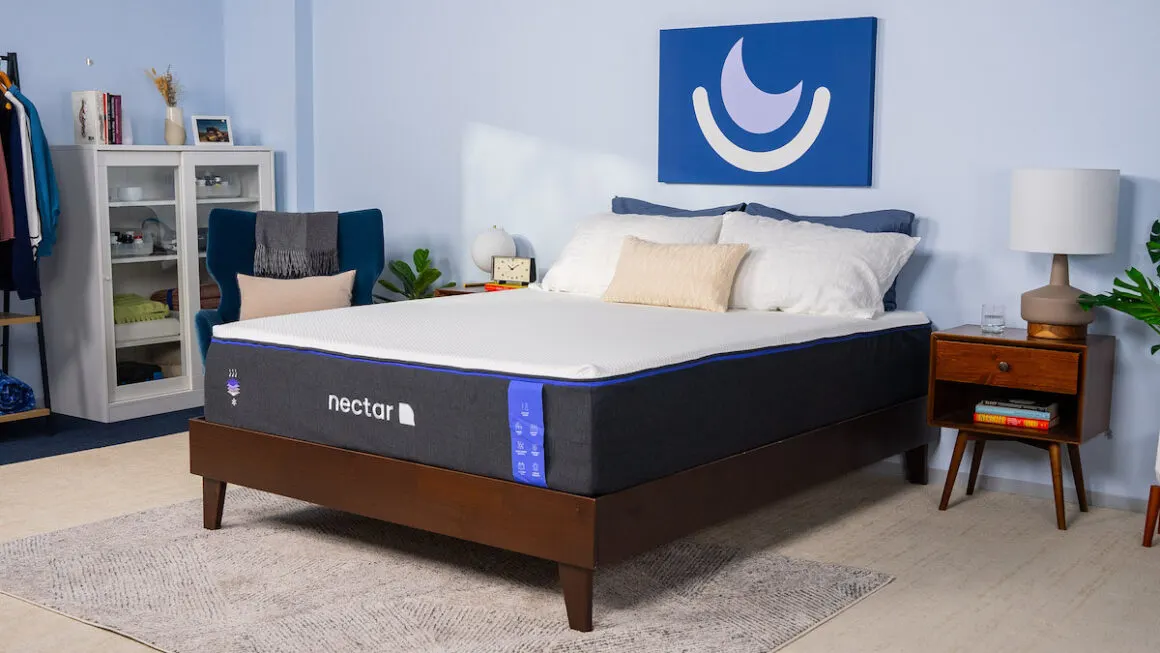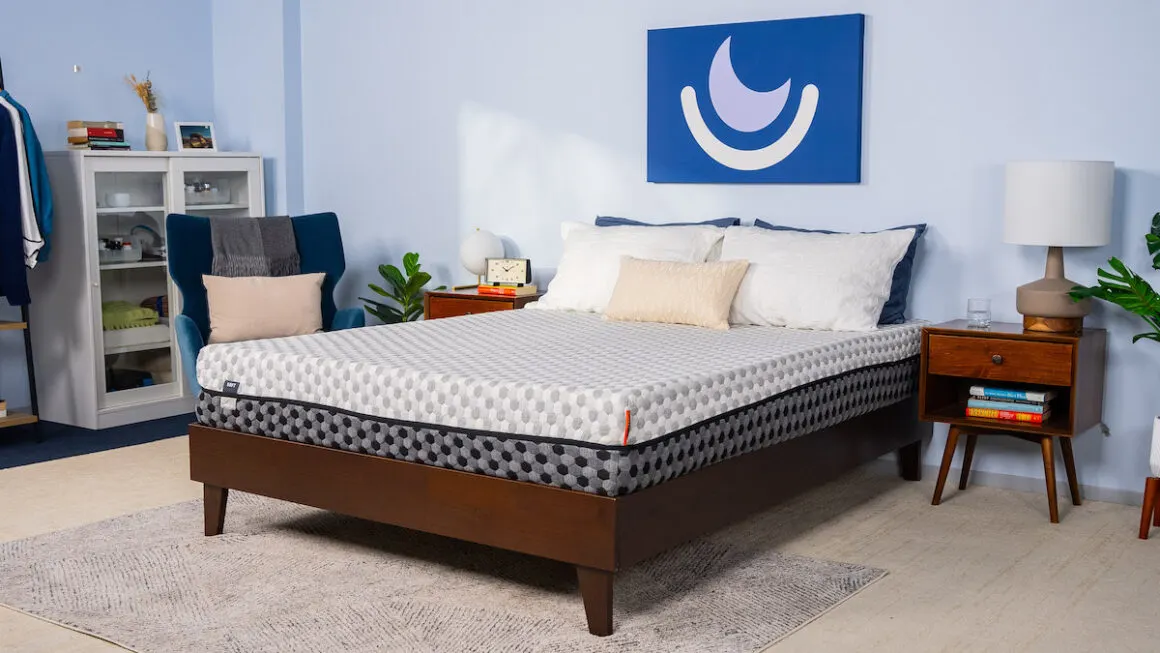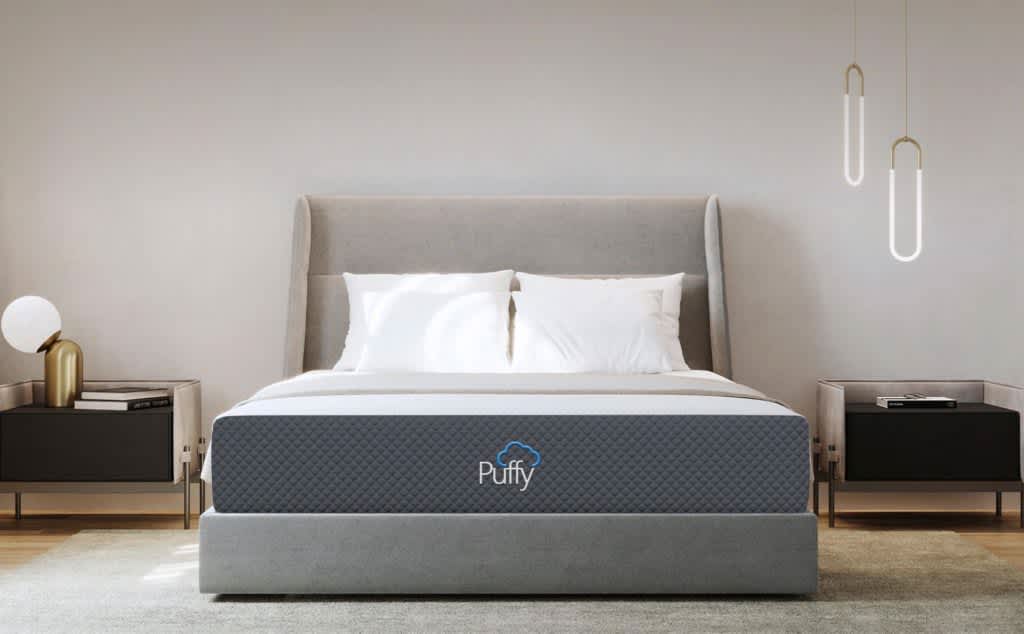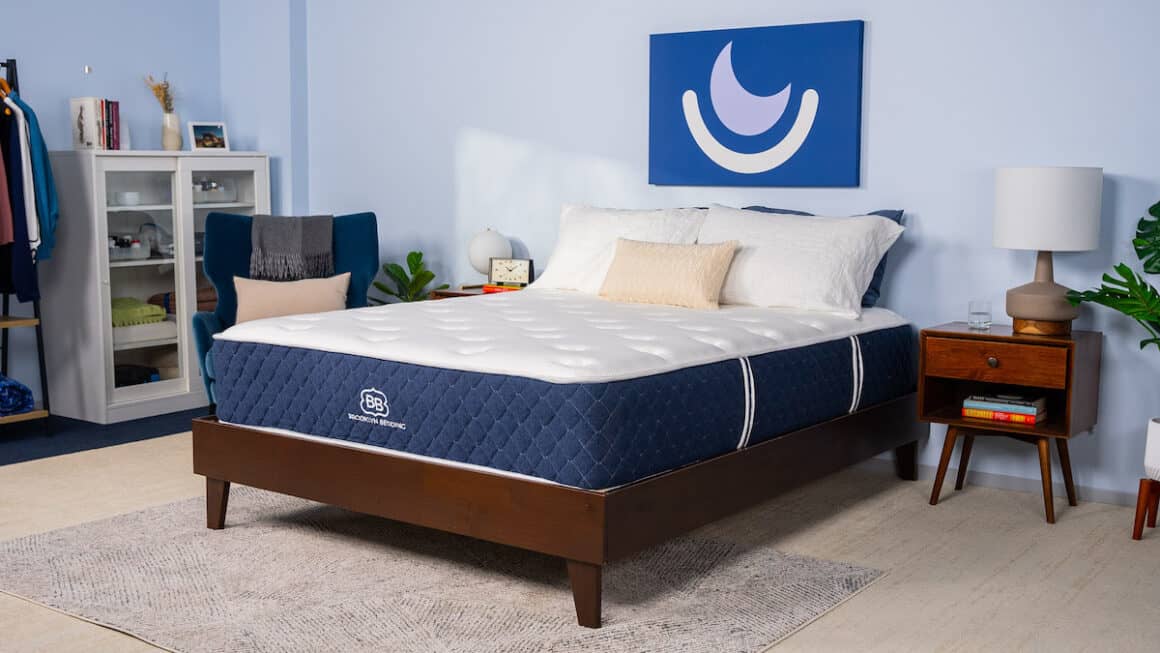Like other sleepers, people under 130 pounds need a mattress that supports the spine and provides cushioning to prevent pressure point buildup. Understanding how your body weight influences the feel of a mattress can help you narrow down your search.
Best Mattress for Lightweight Sleepers
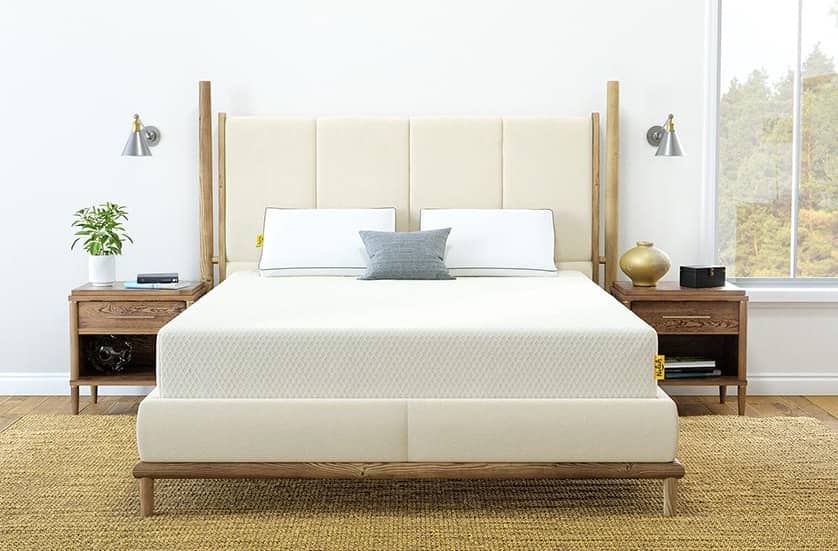
Nolah Original 10
The Nolah Original 10 has a well-rounded feel that works particularly well for back and side sleepers under 130 pounds. The foam layers offer comfortable cushioning, but not so much that you feel like you’re sinking into the mattress.
Our team tried over 1,000 mattresses and chose the best models after reviewing data from the lightweight sleepers on our team. We’ll explain why each model made the cut and what makes it a worthy choice for lightweight sleepers. You’ll also learn what to look for when mattress shopping on your own.
Our choices for the best mattresses of 2024 also include models appropriate for lightweight sleepers. Sleepers who are looking for targeted pain relief should consider our picks for the best mattresses for back pain.
The Best Mattresses for Lightweight Sleepers
Best Overall – Nolah Original 10
Best Value – Nectar Mattress
Best for Side Sleepers – Layla Memory Foam Mattress
Best for Back Pain – Puffy Mattress
Best Pressure Relief – Brooklyn Bedding Signature Hybrid
Read on to see why the following five options made our top picks list of 2024’s best mattresses for lighter weight sleepers.
Sleep Doctor’s Picks
Best Overall Mattress
Nolah Original 10
The Sleep Doctor’s Review
The Nolah Original 10 excels at relieving pressure and providing the right level of support for sleepers who weigh under 130 pounds. The multiple layers of plush foam also isolate motion well for couples sharing a bed.
Buy From NolahCouples
Medium
Close-Conforming Foam
Good Value
Pros
- Ample pressure relief for back and side sleepers under 130 pounds
- Relatively good edge support for an all-foam mattress
- All-foam construction isolates motion well
Cons
- Prone to off-gassing after unboxing
- Doesn’t offer enough support for co-sleepers over 230 pounds
Why We Like It
All-foam beds like the Nolah Original are excellent choices for lightweight sleepers. Nolah’s unique foam formulations offer a great mix of contouring, responsiveness, and support for sleepers with a smaller frame.
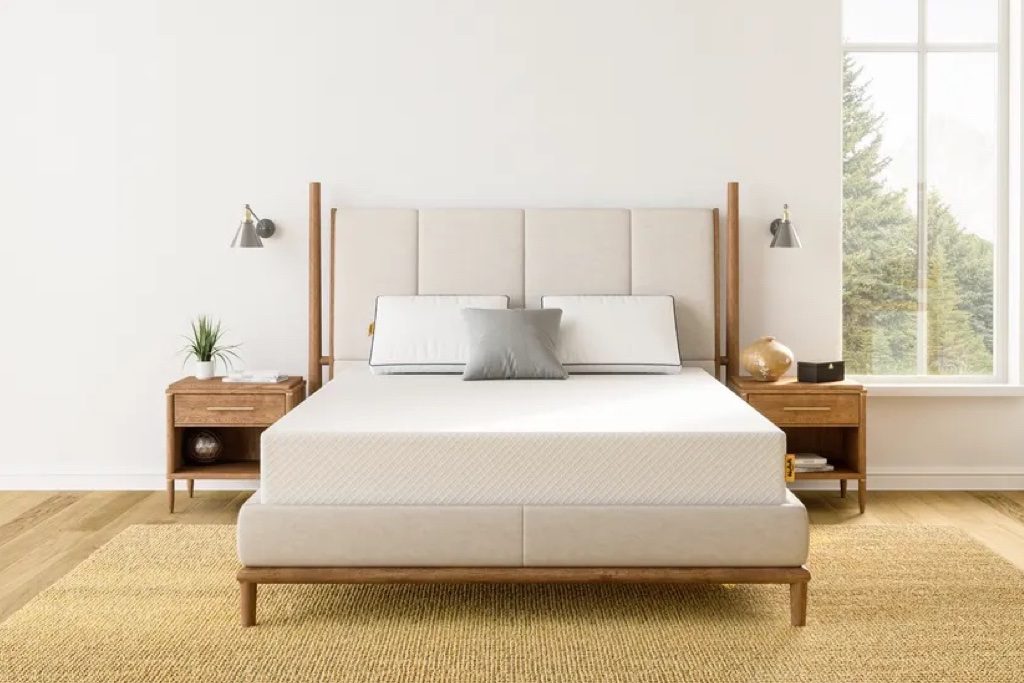
How Does It Feel?
The Nolah Original 10 is a 10-inch all-foam mattress with a medium (5) feel that’s ideal for most lightweight sleepers. This bed features a 2-inch top layer of Nolah’s proprietary polyfoam that’s designed to evenly distribute your weight and prevent the build up of body heat. An additional layer of responsive polyfoam and a thick core of high-density foam add support and stability.
The Nolah Original’s layers offer plenty of contouring and pressure relief for lighter people prone to pressure points, especially side sleepers. However, we found it’s also supportive enough for back and stomach sleepers under 130 pounds. The overall construction is relatively cool compared to many all-foam beds.
Best Value Mattress
Nectar Mattress
The Sleep Doctor’s Review
The Nectar Mattress combines quality materials and plush comfort for lightweight sleepers. Gel-infused memory foam gives the deep contouring needed to relieve pressure, while a full year sleep trial and a low price tag make this bed an excellent value.
Buy From NectarBudget Shoppers
Medium Firm
Close-Conforming Foam
Great Value
Pros
- Durable build compared with other models in this price range
- Medium firm (6) feel provides support for most sleeper types and weights
- Strong motion isolation and edge support
Cons
- Highly contouring surface can stifle movement
- Lacks support for stomach sleepers over 230 pounds
- May be too firm for some lighter individuals
Why We Like It
With excellent pressure relief and ample support, we think the Nectar Mattress will meet the needs of most lightweight sleepers. However, what really stood out to our testing team was a price tag that’s well below the average for an all-foam bed.
How Does It Feel?
The 12-inch, medium firm (6) Nectar Mattress is an all-foam bed with a memory foam and polyfoam comfort system. Gel-infused memory foam in the top layer provides excellent contouring and pressure relief. An additional layer of polyfoam adds a slight springiness to the feel of the bed, while the thick support core keeps the Nectar Mattress supportive and durable.
Our lighter testers were impressed with the Nectar Mattress’ ability to ease tension at key pressure points while supporting the spine in every sleep position. The Nectar provides substantial pressure relief and support for side, back, and stomach sleepers under 130 pounds. Couples should also enjoy the bed’s outstanding motion isolation.
Best Mattress for Side Sleepers
Layla Memory Foam Mattress
The Sleep Doctor’s Review
The Layla Memory Foam Mattress’ plush, deeply contouring memory foam offers very good pressure relief for lightweight side sleepers. The clever, flippable design with two firmness levels also makes this a versatile choice for sleepers who want more options or who may need to adjust the firmness level in the future.
Buy From LaylaSide Sleepers
Medium Soft, Firm Sides
Close-Conforming Foam
Great Value
Pros
- Flippable design with two sleep surfaces: medium soft (4) and firm (7)
- Softer side has deep pressure relief that works well for side sleepers
- Zoned transitional layer on soft side offers targeted support
Cons
- Flipping between sides may require more than one person to move the bed
- Edges sink considerably under weight
- The soft side’s deep contouring can make it more difficult to change positions
Why We Like It
The Layla Memory Foam Mattress is plush and cushiony yet supportive for lightweight people who sleep on their side. The memory foam comfort layer eases tension while the polyfoam adds support and ensures the bed stays relatively cool throughout the night. The flippable design makes this bed one of the more versatile options on the market.
How Does It Feel?
The Layla Memory Foam Mattress is a flippable memory foam bed that offers two firmness options in one. Simply flip the mattress to choose between a medium soft (4) side and a firm (7) side. The bed features copper- and gel-infused memory foam on each side. The softer side also includes a layer of polyfoam.
The softer side’s deeply contouring feel is one of the most comfortable beds for lighter side sleepers that we’ve tested. Layla’s memory foam hugs the body, providing considerable pressure relief for the hips and shoulders. This construction also significantly reduces motion transfer for couples sharing a bed.
Best Mattress for Back Pain
Puffy Cloud Mattress
The Sleep Doctor’s Review
The Puffy Cloud Mattress received top scores from our lightweight back and side sleepers. The bed’s plush comfort comes from its cushioning memory foam top layer that hugs the spine and relieves tension in the lower back. The bed’s medium (5) firmness is also supportive enough to ensure healthy spinal alignment.
Buy From PuffyBack Sleepers
Medium
Close-Conforming Foam
Fair Value
Pros
- High-density polyfoam core provides support to help combat back pain
- Memory foam stops motion transfer and alleviates pressure point discomfort
- Suitable for side, back, and stomach sleepers under 130 pounds
Cons
- Hot sleepers may get too warm
- Tough to move around on the body-hugging surface
Why We Like It
The Puffy Cloud Mattress is one of the most comfortable and supportive mattresses for lightweight sleepers that we’ve tested. Its excellent balance of pressure relief and support make this a great choice for sleepers who experience back pain.
How Does It Feel?
The Puffy Cloud Mattress is a 10-inch all-foam bed with a medium firmness level. The bed features a memory foam and polyfoam comfort system and a thick polyfoam support core. The memory foam layer helps evenly distribute body weight and relieve tension at key pressure points, while the polyfoam layers provide balanced support to the spine.
Our lightweight sleep testers were impressed by the Puffy Cloud Mattress’ performance. The bed’s memory foam layer offered ideal cushioning for the hips and shoulders of our side sleepers and the lumbar region for our back sleepers. However, despite specially formulated cooling layers, the Puffy Cloud Mattress has a tendency to retain some body heat, which may bother people who sleep hot.
Best Mattress for Pressure Relief
Brooklyn Bedding Signature Hybrid
The Sleep Doctor’s Review
The Brooklyn Bedding Signature Hybrid offers versatile comfort for lightweight sleepers. With three firmness options, this bed is comfortable for back, side, and stomach sleepers alike. The hybrid design has substantial pressure relief without sacrificing ease of movement, and the bed’s pocketed coils impart a slight bounce and plenty of support.
Buy From Brooklyn BeddingCombination Sleepers
Soft, Medium Firm, Firm Options
Bouncy, Supportive Surface
Great Value
Pros
- Medium soft (4) and medium firm (6) models provide top-notch support for people under 130 pounds
- Quilted top and foam comfort system cushion pressure points
- Coil system strengthens the edges and helps keep a neutral sleep temperature
Cons
- Performance varies significantly between firmness levels
- Firm option does have enough cushioning for lighter individuals
- Sensitive sleepers may wake to their partner’s movements
Why We Like It
The Brooklyn Bedding Signature Hybrid combines foam layers with a pocketed coil support core. This hybrid design offers an impressive mix of pressure relief and excellent support with a slight bounce. As a result, the soft and medium firm models of the Brooklyn Bedding Signature Hybrid have the contouring needed for sleepers with smaller builds.
How Does It Feel?
The Brooklyn Bedding Signature Hybrid comes in three firmness options: medium soft (4), medium firm (6), and firm (8). The bed features a cotton cover with a quilted polyfoam layer for added plushness. Each version has a two-layer comfort system with different foam formulations to achieve the varying firmnesses. All models have an 8-inch support core of pocketed coils and a high-density polyfoam base layer for added stability.
The medium soft version of the Brooklyn Bedding Signature Hybrid offered the best pressure relief for our side sleepers under 130 pounds, who said they need extra cushioning for their hips and shoulders. Our lightweight back sleepers also enjoyed the contouring of the softer option. The medium firm version had the best level of support for lighter stomach sleepers.
Weight disclaimer
Please note: For the purposes of this page, we are referring to individuals who weigh 130 pounds or less. Although we use the terms “light” or “lightweight” for brevity and convenience, we do not use weight categories such as “average” or “overweight,” as they can be misleading and dependent on the individual.
We use weight categories as a practical standard of size when discussing how mattresses interact with sleepers’ bodies. We have found that individuals who weigh under than 130 pounds generally have similar needs for a mattress in terms of firmness, thickness, and other factors, with small indivi.dual variations
What Is the Best Mattress Firmness for Lightweight Sleepers?
We measure firmness using a scale that goes from 1 to 10. Softer mattresses are assigned lower numbers, while firmer models get higher numbers. Your favorite sleeping position, weight, and preferences all play a role in what kind of firmness level is most supportive and comfortable, whether that’s firm vs. soft.
Sleepers under 130 pounds typically prefer softer mattresses than people who weigh more, because they don’t compress the mattress as deeply. Firm mattresses can cause lightweight sleepers to develop pressure points.
However, it’s not as simple as choosing the softest mattress available. Sleeping position is a critical factor. Stomach, back, and side sleepers each prefer distinct firmness levels because their weight spreads out differently across the mattress.
When sleeping on your side, the mattress should flex to allow your hips and shoulders to sink in slightly, while supporting the natural curve of the lower back. For back sleepers, a slightly firmer surface is needed to keep the spine on an even plane, but you still want some contouring in the lumbar area.
Although people under 130 pounds tend to stay mostly on top of the mattress as opposed to sinking in, we still recommend a firmer bed for stomach sleepers to prevent excessive sinkage in the midsection that can pull the spine into an unnatural curve.
| Sleeping Position | Recommended Firmness for Lightweight Sleepers |
|---|---|
| Side Sleepers | Soft (3) to Medium (5) |
| Back Sleepers | Medium Soft (4) to Medium Firm (6) |
| Stomach Sleepers | Medium Soft (4) to Medium Firm (6) |
| Combination Sleepers | Medium Soft (4) to Medium Firm (6) |
How to Choose a Mattress for Lightweight Sleepers
Firmness is only one of the factors you should consider when choosing the best mattress. Knowing the mattress type and how it rates on various performance metrics can also give you an idea of how it will feel.
Mattress Type
Most mattresses are classified as one of five types: foam, latex, hybrid, innerspring, or airbed. Each mattress type has its own pros and cons.
Foam: Foam mattresses have a comfort system and a support core made entirely from polyfoam, memory foam, or both. They usually relieve pressure points well, which lightweight sleepers often appreciate.
Hybrid: Hybrid mattresses have a support core made from pocketed coils, which lend bounce and airflow. The comfort system can contain foam, latex, micro-coils, or other materials.
Latex: Latex is a naturally resilient material that’s breathable and easy to move on. However, while softer models exist, latex doesn’t tend to offer the close-conforming hug of memory foam.
Airbed: An airbed has adjustable firmness levels, thanks to its air-filled support core. You can change the feel instantly using a remote or app. Despite their high price tag, airbeds may be worthwhile for lightweight people who sleep with a larger partner, as each person can control their own side of the bed.
Many mattresses come in split options like split king or split queen, which can be helpful for those under 130 pounds if they share a bed with someone above that weight range. Choosing a split bed allows both partners to enjoy their ideal firmness level.
Spinal Alignment
Ideally, your mattress should keep your spine on an even plane from your neck to your lower back. Firmness level, mattress structure, contouring, body weight, and sleeping position all impact how supported your spine feels while you sleep.
While lightweight sleepers generally don’t require as much structure, it’s still important to have enough support to prevent the spine from curving. For example, stomach sleepers who use a mattress that’s too soft can sink in around the weight-bearing midsection, so it’s important to have a supportive core that pushes back. On the other hand, side and back sleepers may require more contouring to accommodate the shape of the spine.
Responsiveness
A responsive mattress is quick to regain its original shape when pressure is lifted,giving you the feeling that you’re sleeping “on” instead of “in” your bed. If you want to be able to switch sleeping positions easily or if you have limited mobility, you may prefer a responsive mattress over a closer-conforming model. Hybrid, innerspring, and latex beds tend to be more responsive than foam mattresses.
Motion Isolation
Motion-isolating mattresses prevent movement from transferring from one side of the bed to the other. People who easily wake from their partner’s shifting may appreciate sleeping on a mattress that isolates motion well. All-foam mattresses generally score highly during our motion isolation tests.
Breathability
Airflow is important to consider when choosing a mattress, especially if you’re a hot sleeper. Materials like dense memory foam don’t allow air to flow well, which can translate to a warm sleep surface. If you like the feel of memory foam but run hot, look for a mattress with cooling technology like open-cell foam, phase change material, or gel infusions.
Innerspring, hybrid, and latex mattresses usually regulate temperature effectively because air flows through their materials instead of getting trapped within them.
Video: How to Choose the Best Bed for You
Watch our video as our sleep experts walk through everything you need to know to choose the perfect mattress for your needs.
Discover More Mattress Solutions
Our team has developed dozens of guides to help you pick the perfect mattress, no matter your needs.
How We Test
Our testing team has nearly a decade of experience with over 1,000 mattresses tested. Our sleep lab methodology is thorough and unbiased. We test every mattress for critical features like pressure relief, support, and motion isolation – three factors that are often important to people under 130 pounds.
To find the best mattresses for lightweight sleepers, we chose mattresses that scored highly with the lightweight sleepers on our team and made sure to include rankings from stomach, back, and side sleepers.
Frequently Asked Questions
The best mattress for lightweight sleepers is one that supports the spine while cushioning potential pressure points. While lightweight sleepers can find suitable models in all mattress types, conforming materials like memory foam and latex are popular for this weight group as they help cushion joints and sore spots.
Because they don’t compress their mattress as deeply as people with more weight, lightweight sleepers often prefer softer mattresses than people who weigh over 130 pounds. Depending on their preferred sleep position, lightweight sleepers typically favor mattresses with firmness levels between soft (3) and medium firm (6) because models in this range promote spinal alignment without feeling uncomfortably hard.
There is no one-size-fits-all best mattress type for lightweight sleepers. Foam, latex, hybrid, innerspring, and airbed mattresses can all be suitable options for people under 130 pounds. Foam is better for those who want motion isolation and pressure relief, while hybrids, latex, and innerspring beds are ideal choices for hot sleepers and people who like a responsive feel. If you’re looking for adjustable firmness and have a large budget, you may be interested in an airbed.
Lightweight sleepers who share a bed with a heavier partner may find a split king mattress or airbed beneficial. Split kings and split queens allow each partner to choose a firmness level that suits their individual needs. With an airbed, you and your partner can each adjust your respective side of the bed to the right feel and firmness. Alternatively, using a mattress topper on your side of the bed is a cost-effective way to get a customized feel.
Ask the Sleep Doctor
Have questions about sleep? Submit them here! We use your questions to help us decide topics for articles, videos, and newsletters. We try to answer as many questions as possible. You can also send us an email. Please note, we cannot provide specific medical advice, and always recommend you contact your doctor for any medical matters.
